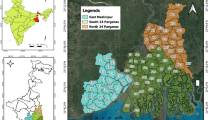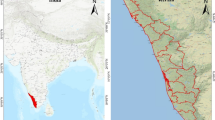Abstract
The influence of topographic effects in optical satellite imagery is not investigated very extensively in the Himalayan terrain. The topographic variability causes a problem of differential illumination due to steep and varying slopes in rugged Himalayan terrain. Therefore, topographic corrections are essential for qualitative and quantitative analysis of snow cover applications. The present paper discusses the implementation of different topographic correction models on AWiFS sensor onboard IRS P6 satellite images and the qualitative and quantitative comparative analysis in detail. Both the Lambertian and non-Lambertian assumptions have been considered in the present analysis with the aim to explore best suitable empirical model for rugged terrain. The main topographic methods implemented are:
-
•
C-correction
-
•
Minneart corrections
-
•
Civco’s modified version of cosine correction
-
•
two-stage normalization and
-
•
slope matching technique.
Lambertian assumptions are found to be very unrealistic over Himalayan terrain as these lead to either underestimation or overestimation of physical parameters significantly both on sunlit slopes as well as the slopes away from the Sun. This problem is overcome by considering non-Lambertian assumption. Minneart constant and C-correction coefficients for all AWiFS satellite bands are estimated using regression analysis. All the results due to topographic effects are investigated qualitatively and quantitatively using four criteria namely visual analysis, validation with field measurements (in-situ observations), spectral reflectance of training samples of snow on the south and north aspects and graphically. The visual analysis confirms the minimization of three dimensional relief effects in two-stage normalization and slope matching methods and retrieves some of the information under mountain shadow. Due to the very bright surface of snow fields there is likely to be more diffuse reflected light in these areas than over darker vegetated surfaces. The qualitative analysis in other methods does not extract any information on shady slopes. The quantitative validation of topographic results in satellite imagery with in-situ observations shows underestimation of spectral reflectance of snow significantly except for slope matching technique. It is also apparent that although all the topographic methods correct the reflectance of training snow samples on the south and north aspects but most acceptable values are achieved using slope matching. The results obtained from graphical analysis reveal that mean reflectance after all topographic corrections are independent of illumination. This study also suggests that the suitability of topographic models can not be concluded as successful based on single criterion. Slope matching technique is the only technique which satisfies all the four criteria successfully and produces the best result for Himalayan terrain.
Similar content being viewed by others
References
Brun E, Martin E, Simon V, Gendre C and Coleou C 1989 An energy and mass model of snow cover suitable for operational avalanche forecasting; J. Glaciol. 15(121) 333–341.
Chavez P S Jr 1989 Radiometric calibration of Landsat Thematic Mapper multispectral images; Photogramm. Eng. Remote Sens. 55 1285–1294.
Chavez P S Jr 1996 Image-based atmospheric corrections revisited and improved; Photogramm. Eng. Remote Sens. 62 1025–1036.
Civco D L 1989 Topographic normalization of Landsat Thematic Mapper digital imagery; Photogramm. Eng. Remote Sens. 55 1303–1309.
Colby J D 1991 Topographic normalization in rugged terrain; Photogramm. Eng. Remote Sens. 57 531–537.
Conese C, Gilabert M A, Maselli F and Bottai L 1993 Topographic normalization of TM scenes thorough the use of an atmospheric corrections method and digital terrain models; Photogramm. Eng. Remote Sens. 59 1745–1753.
Davis R E, Nolin AW, Jordan R and Dozier J 1993 Towards predicting temporal changes of the spectral signature of snow in visible and near-infrared wavelengths; J. Glaciol. 17 143–147.
Deems J S 2001 Topographic controls on spatial and temporal variation in snow temperatures in a mountain snowpack; Proceesing of the 69th Western Snow Conference Sun Valley ID 131–134.
Dozier J 1984 Snow reflectance from Landsat Thematic Mapper; IEEE Trans. Geosci. Remote Sens. 22(3) 323–328.
Duguay C R and LeDrew E F 1991 Mapping surface albedo in the East slope of the Colorado front range, U.S.A., with Landsat Thematic Mapper; Arct. Alps. Res. 23(2) 213–223.
Duguay C R and LeDrew E F 1992 Estimating surface reflectance and albedo from Landsat-5 TM over rugged terrain; Photogramm. Eng. Remote Sens. 58 551–558.
Duguay C R 1993 Modelling the radiation budget of alpine snowfields with remotely sensed data: model formulation and validation; Ann. Glaciol. 17 288–293.
Ekstrand S 1996 Landsat-TM based forest damage assessment: Correction for topographic effects; Photogramm. Eng. Remote Sens. 62 151–161.
Hall D K, Chang A T C and Siddalingaiah H 1988 Reflectances of glaciers as calculated using Landsat-5 Thematic Mapper data; Remote Sens. Environ. 25 311–321.
Hall D K, Riggs G A and Salomonson V V 1995 Development of methods for mapping global snow cover using Moderate Resolution Imaging Spectroradiometer Data; Remote Sens. Environ. 54 127–140.
Haertel V F and Shimabukuro Y E 2005 Spectral linear mixing model in low spatial resolution image data; IEEE Trans. Geosci. Remote Sens. 43(11) 2555–2562.
Holben B and Justice C 1980 The topographic effect on spectral response from Nadir pointing sources; Photogramm. Eng. Remote Sens. 46 1191–1200.
Kasten F 1962 Table of solar altitudes for geographical latitudes; CRREL Special Report, 57 U.S. Army Corps of Engineers, Hanover, New Hampshire.
Kawata Y, Ueno S and Ohtani A 1995 The surface albedo retrieval of mountainous forest area from satellite MSS data; Appl. Math. Comput. 69 41–59.
Law K H and Nichol J 2004 Topographic correction for differential illumination effects on IKONOS satellite imagery; Proceeding of XXth ISPRS symposium.
Leprieur C, Durand J M and Peyron J L 1988 Influence of topography on forest reflectance using Landsat Thematic Mapper and digital terrain data; Photogramm. Eng. Remote Sens. 54 491–496.
Meyer P, Itten K I, Kellenbenberger T, Sandmeier S and Sandmeier R 1993 Radiometric corrections of topographically induced effects on Landsat TM data in an alpine environment; ISPRS J. Photogramm. Remote Sens. 48 17–28.
Minneart M 1941 The reciprocity principle in lunar photometry; J. Astrophys. 93 403–410.
Mishra V D, Negi H S, Rawat A K, Chaturvedi A and Singh R P 2008 Retrieval of sub-pixel snow covered Himalayan region using medium and coarse resolution remote sensing data; Int. J. Remote Sens. (in press).
Mukkoth V N 2004 Snow melt runoff modeling using MODIS in Elaho River Basin, British Columbia; Environmental Information Archieves 2 526–530.
Nichol J, Hang L K and Sing W M 2006 Empirical correction of low sun angle images in steeply sloping terrain: a slope matching technique; Int. J. Remote Sens. 27(3–4) 629–635.
Pandya M R, Singh R P, Murali K R, Babu P N, Kirankumar A S and Dadhwal V K 2002 Bandpass solar exo-atmospheric irradiance and Rayleigh optical thickness of sensors on board Indian Remote Sensing Satellites − 1B, −1C, −1D, and P4; IEEE Trans. Geosci. Remote Sens. 40(3) 714–717.
Riano D, Chuvieco E, Salas J and Aguado I 2003 Assessment of different topographic corrections in Landsat-TM data for mapping vegetation types; IEEE Trans. Geosci. Remote Sens. 41(5) 1056–1061.
Richter R 1997 Correction of atmospheric and topographic effects for high spatial resolution satellite imagery; Int. J. Remote Sens. 18 1099–1111.
Romanov P, Tarpley D, Gutman G and Carroll 2003 Mapping and monitoring snow-cover fraction over North America; J. Geophys. Res. 108 8619.
Smith J A, Lin T L and Ranson K J 1980 The Lambertian Assumption and Landsat Data; Photogramm. Eng. Remote Sens. 46(9) 1183–1189.
Song J and Gao W 1999 An improved method to derive surface albedo from narrowband AVHRR satellite data: narrowband to broadband conversion; J. Applied Meteorol. 38 239–249.
Song C, Woodcock C E, Seto K C, Lenney M P and Macomber A S 2001 Classification and change detection using Landsat TM data: when and how to correct atmospheric effects; Remote Sens. Environ. 75 230–244.
Srinivasulu J and Kulkarni A V 2004 Estimation of spectral reflectance of snow from IRS-1D LISS-III sensor over the Himalayan terrain; Proc. Indian Acad. Sci. (Earth Planet. Sci.) 113 117–128.
Teillet P M, Guindon B and Goodenough D G 1982 On the slope aspect correction of multispectral scanner data; Canad. J. Remote Sens. 8 84–106.
Tokola T, Sarkeala J and Van der Linden M 2001 Use of topographic correction in Landsat TM-based forest interpretation in Nepal; Int. J. Remote Sens 22 551–563.
Upadhyay D S 1995 Snow melt processes; Cold Climate Hydrometeorology. New Age Int. Pvt. Ltd. Publ., 213–230.
Van Der Meer F 1996 Spectral mixture modeling and spectral stratigraphy in carbonate lithofacies mapping; ISPRS J. Photogramm. Remote Sens. 51 150–162.
Xin L, Koike T and Guodong C 2002 Retrieval of snow reflectance from Landsat data in rugged terrain; Ann. Glaciol. 34 31–36.
Author information
Authors and Affiliations
Corresponding author
Rights and permissions
About this article
Cite this article
Mishra, V.D., Sharma, J.K., Singh, K.K. et al. Assessment of different topographic corrections in AWiFS satellite imagery of Himalaya terrain. J Earth Syst Sci 118, 11–26 (2009). https://doi.org/10.1007/s12040-009-0002-0
Received:
Revised:
Accepted:
Published:
Issue Date:
DOI: https://doi.org/10.1007/s12040-009-0002-0




